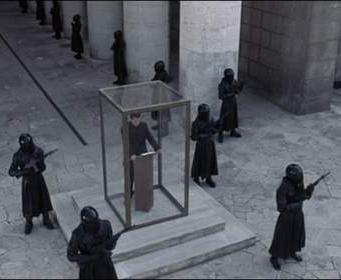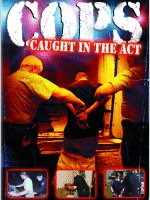(Via Austro-Athenian Empire 2007-11-08, Manuel Lora @ LewRockwell.com Blog 2007-11-08, and The Agitator 2007-11-08.)
Cops in America are heavily armed and trained to be bullies. They routinely force their way into places they have no business being, use violence first and ask questions later, and pass off even the most egregious forms of violence against helpless people as self-defense
or as the necessary
means to accomplish a completely unnecessary goal. In order to stay in control of the situation,
they have no trouble electrifying small children, alleged salad-bar thieves, pregnant women possibly guilty of a minor traffic violation, or an already prone and helpless student who may have been guilty of using the computer lab without proper papers on hand. They are willing to pepper spray lawyers for asking inconvenient questions and to beat up teenaged girls for daring to give them lip over cleaning up spilled cake or being out too late at night. Whenever they are caught using harsh enough violence against someone who is so obviously innocent or helpless that the media takes notice, police administrators will wring their hands, say something noncommittal, make up some lies as possible excuses for the assault, promise an investigation, find that Official Procedures were followed, and then do nothing at all. Meanwhile a chorus of sado-fascist bully boys will reliably cheer the pigs and smear the victim in print media, talk shows, and the Internet. Both administrators and freelance police enablers freely employ the most tortured sorts of necessity
excuses, in what seems to be a deliberate effort to obliterate any notion of restraints on the use of force in securing police objectives. Then they will sanctimoniously explain how cops need to be able to beat the hell out of you with impunity so that they can protect
you.
For example, when the cops in Chicago aren’t too busy running elite
criminal rackets, they have found another way to serve and protect the public: by forcing their way into an 82-year-old black woman’s apartment, and then grabbing a taser and serving and protecting the hell out her.
As shocking as it is that a Chicago Police officer Tasered an 82-year-old grandmother during a wellness
check, it’s even more disheartening that so many of our readers believe the police action was appropriate.
By late Tuesday, 7,967 people had responded to the Chicago Sun-Times Web site poll question:
Should cops have Tasered an 82-year-old?
Sixty-three percent responded no.
But 37 percent, or 2,940 people voted yes — Lillian Fletcher, the elderly and mentally-ill grandmother who was Tasered by police who burst into her home, should have been Tasered because she was wielding a hammer.
That’s scary.
Mind you, Fletcher had not broken any laws, police were not executing a search warrant, and the elderly woman had not been threatening neighbors with the hammer. In fact, she didn’t grab the hammer until officers forced their way into her garden apartment.
After the Tasering, Fletcher, who suffers from dementia and schizophrenia, was hospitalized for five days and may have to undergo surgery for fluid on the brain.
Instead of condemning the police action, many of the people who shot me an e-mail blamed the elderly woman’s family for the fiasco.
What about the family that left their mother home alone knowing she had all these issues,
said Dave M. Put the blame where it really belongs: on the family. Why don’t you stop by and visit good old granny and when she starts swinging a hammer at you just take your beating and give her a hug.
Well, Dave M., I did visit Fletcher at her home on Monday night, and she didn’t pull out a hammer. You know why? I didn’t push my way into her home. I rang the doorbell. When she ushered me into her kitchen and invited me to sit, I sat. And when our chat was over, I put on my coat, said Good night
and made sure she locked her door behind me.
In other words, I respected her space — something police didn’t do.
As for her family, they aren’t the triflin’ people some of you are depicting. In fact, if anyone is to blame for what’s happened, it would be the city’s Department of Aging.
Fletcher, who can be belligerent, told a caseworker to go away. But instead of leaving, the worker called the police, and officers treated Fletcher like she was a criminal.
— Mary Mitchell, Chicago Sun-Times (2007-11-07): Cops wouldn’t take ‘no’ for an answer
So Ms. Fletcher decides that she doesn’t want a nosy social worker in her apartment and tells her to go away. Said professional busybody calls the cops on her so that they can force their way into her apartment against her will. When these armed strangers come breaking through the door, she naturally tells them to get out and tries to protect herself. So they knock her down with an immobilizing and painful electric shock. and hurt her so badly that she has to spend five days in the hospital. Normally, if armed strangers went busting into an apartment against the tenant’s will and then protected
themselves by tasering their outraged victim, it would be called breaking and entering
and assault and battery.
But because the armed strangers are cops, and because their victim could safely be dismissed by the powers that be as old and black and crazy, this is called a wellness check.
Apparently, it was necessary to taser the old woman in order to save her.
Since this story first hit the Chicago media, Mayor Daley feels embarassed, but won’t say anything bad about the cops who did it. He assures us that The Matter Will Be Investigated. Meanwhile, Alderman Isaac Carothers, the chair of the city council committee dealing with police matters, has this to add:
It’s very unfortunate that it had to result to that, but I certainly understand. I’m pleased that they decided not to shoot her and they decided not to tackle her and that they didn’t use the night stick, which may have been options if someone is swinging a hammer at you.
–Quoted by Fran Spielman, Chicago Sun-Times (2007-11-08): Tasering grandma displeases Daley — But he avoids criticizing cops
Well, yes, at least the pigs didn’t shoot her while they were at it. That’s mighty white of them.
It remains to be seen what, if anything, will happen to these cops. The Fraternal Order of Pigs, as usual, has their back. There’s an investigation going on by the so-called Office for Professional Standards. But somehow I wouldn’t be surprised if not a damn thing comes of it.
Which is precisely what happened in another case over in Pittsburgh, where a black 29-year-old man was tasered while he slept in his own home. He got in late and forgot to disarm a security device on the house, which issued a silent alarm to the police department. The cops showed up, found him asleep on the couch, surrounded him, jabbed a taser into his back, and shocked him while he was still asleep.
I felt a lot of voltage going through my body,
Mr. Hicks said recalling the events of that late July weekend. That’s what woke me up.
Jumping to his feet, Mr. Hicks was aware of an intense sensation between the shoulder blades of his 150-pound body. It didn’t stop there. His whole body felt as if it were on fire.
When his eyes finally adjusted to the light, his heart skipped yet another beat. Two North Braddock police officers, Gerard Kraly and Lukas Laeuricia, were standing in his living room. To this day, Mr. Hicks still doesn’t know which is Kraly and which Laeuricia.
The shorter of the two officers did most of the talking. His mustached partner was a burly over-6-footer in his late 30s or early 40s. He held the Taser, the prongs of which were sticking in Mr. Hicks’ back.
The polite family newspaper version of what Mr. Hicks said in response to being electrified translates roughly as What’s going on here?
The shorter cop, whom Mr. Hicks remembers as blond, asked him to calm down.
The officer said that North Braddock police received a call from the security company monitoring Mr. Hicks’ home. They believed a break-in was in progress.
The cops had entered the home, turned on the light and found Mr. Hicks asleep on the sofa. If they identified themselves or ordered him to get up, Mr. Hicks said he did not hear it. He said he wasn’t aware of their presence until he was shot in the back with a Taser.
According to Mr. Hicks, the cops were skeptical. How do we know that you’re who you say you are?
the shorter of the two cops asked.
At that point, the cop holding the Taser squeezed the trigger, sending Mr. Hicks into paroxysm of agony. It was not a short jolt like the first one he received. He fell to the floor. His screams woke the neighbors.
What do you want?
Mr. Hicks asked. Please stop [shooting] me.
The shorter cop helped him to his feet. Swaying unsteadily, he offered to show them his identification. They searched him and found his wallet. After inspecting it, they threw the wallet on the coffee table.
I told you I lived here and that I’m the legal resident,
he shouted, believing he finally had justice, common decency and the angels of heaven on his side. A staff member at the African-American Chamber of Commerce of Western Pennsylvania, Mr. Hicks counts himself on the side of the law-abiding citizen.
The cop with the Taser squeezed the trigger again, anyway. Mr. Hicks flapped his arms wildly, but didn’t fall. All he could do was scream loud enough to be heard all over the Mon Valley.
After removing the pellets from his bloody back, the cops handcuffed Mr. Hicks and led him out his front door to a police van. They did not read him his rights, Mr. Hicks says. The back of his shirt was soaked with warm, sticky blood.
Meanwhile, cops from six neighboring boroughs searched the house for other burglars.
Mr. Hicks’ mother, Arlene, arrived just as her son was being escorted out the door. She had Mr. Hicks’ 11-year-old daughter and a niece in tow. Why are you arresting my son?
she asked. The taller of the two cops answered that he didn’t have to tell her anything.
When Mrs. Hicks persisted, he said her son was being arrested for being belligerent.
In the van, Mr. Hicks said he told the cops he needed medical attention. He says they told him he would wind up in county lockup if he insisted on it. Never mind,
Mr. Hicks said.
Mr. Hicks sat in a holding cell until 5 a.m. The cops returned. We’re not filing charges,
they told him. You’re free to go, but if you get into trouble in the next year, we will file charges.
Mr. Hicks staggered into the parking lot and began walking the 10 minutes to the Braddock hospital, refusing another officer’s offer of a ride home. He was examined and released that morning. Mr. Hicks filed a detailed police complaint the following Monday, but the case didn’t come to public attention until the New Pittsburgh Courier’s front-page story last week.
— Tony Norman, Pittsburgh Post-Gazette (2007-09-11): Tasered at his own home: the Shawn Hicks story
So once again, a gang of armed strangers break into a house in the name of protecting
the people living in it from a suspected burglar. They taser first and ask questions later. They blast a completely innocent man — one of the people who they were supposedly showing up to protect
— with a painful shock electricity while he is sleeping. While outnumbered, physically overmatched, and with a taser still jabbed in his back, he gets a bit upset, demands to know what is going on, and explains that he lives in the house they are supposedly protecting; they call him a liar and shock him again. After they find his wallet and confirm that he is, in fact, a legal occupant, they shock him again, arrest him for getting uppity, refuse him medical attention, and then give him a sanctimonious lecture not to get into any trouble. And because this gang of thugs were uniformed cops, and because the man they were protecting
the hell out of could be dismissed as black and belligerent,
precisely nothing has happened. There was no investigation at all until the media publicized the story months later. Last week the local D.A. announced that no charges would be filed against Gerard Kraly or Lukas Laeuricia. Another bunch of area cops Investigated the Matter and decided that there was no criminal matter to be pursued.
Shawn Hicks is planning to file a civil suit over the abuse. I hope that he sues the pigs personally and takes them for everything they’ve got. Unfortunately, if a suit is filed, what will probably happen is that the city government will settle the case out of court, then send the bill to a bunch of innocent taxpayers, while the thugs Kraly and Laeuricia will keep on terrorizing innocent people in the name of public safety.
If you’re baffled that cops could get away with these kind of outrages, it may help to remember that in a lot of American cities, there is no such thing as a civil police force anymore. What we have would be better described as thuggish paramilitary units occupying what they regard as hostile territory. Here as elsewhere, they are going to serve and protect
us, whether we want them to or not, and if we don’t like it then they’ve got plenty of guns and clubs and cuffs and 50,000 volt human prods in order to make sure we get good and protected anyway.
Further reading:


 A violent gang has recently been taken down in inner-city Chicago.
A violent gang has recently been taken down in inner-city Chicago.